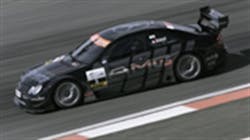Customer: "I just bought $3,000 worth of ultra-high performance tires and wheels from you, and the first time I threw the car into a tight turn, I felt the car twist and flex terribly! It never did that before. What´s wrong with the tires?"
If you´ve ever been on the receiving side of this comment, you already know that you didn´t properly identify and educate your customer (maybe former customer) before making the sale. Remember, some people will not necessarily "feel" or recognize flex.
There are really two extremes when it comes to your customers. One wants the ultimate in performance and handling, even at the expense of ride comfort. This customer wants the lowest profile ultra-high performance tires mated to a chassis that is rock solid and intends to drive very aggressively. The other customer wants the "look" with tires and wheels, but has no plans to ever use the maximum adhesion the new tires will provide.
The first thing you must do whenever selling a customer ultra-high performance tires is to find out how the vehicle will be driven. If you find out that you´re dealing with a hard-driving person, then read on, because you may be in a position to sell additional chassis stiffening parts and services.
Vehicles that feature MacPherson strut or modified struts are constructed in a unibody approach, which means that the vehicle "tub" incorporates a welded frame/body substructure. This means that the entire body substructure flexes to a degree as the vehicle rides over bumps, brakes, or is subjected to lateral loads during turns. The degree of flex will differ depending on specific design and construction, but some degree of flex will occur and is normal.
However, in order to squeeze the maximum handling performance from a unibody vehicle, we should address this issue in order to minimize the amount of flex. As the chassis flexes and distorts, a degree of cornering energy is wasted.
Instead of lateral grip achieved by the tires transmitting this energy directly to your "seat," a degree of this energy is lost through a variety of variables that "flex" and consume this energy. These areas include, as examples, the sidewall flex of the tires, flex in the wheels, suspension bushing distortion and body/chassis flex. Here we´ll offer tips on reducing this wasted energy as it relates to the chassis.
[PAGEBREAK]
STRUT TOWER BRACES
On any strut-equipped vehicle, one of the most common areas of flex involves the strut towers (the top of the towers, where the struts attach). During turns, these towers tend to distort (momentary bending), which can cause the strut mounting points to move inboard and outboard. This results not only in lost energy, but also in small, temporary changes in camber, caster and toe angles.
In order to reduce or eliminate this particular area of flexing, a strut tower brace can be installed. This is a steel or alloy bar brace that connects the right and left strut tower together (and often also attaching to the firewall as well). By connecting right side to left side towers, this prevents a single tower from moving in relation to the opposing side tower. By also attaching to the firewall, this provides a center locating point, preventing unwanted tower movement on both sides. These bars (also known as "stress bars") serve to stiffen the chassis, reducing flex that occurs during severe handling maneuvers.
Considering the enormous amount of flex that can occur in today´s unibody chassis, these bars are a valuable add-on for any serious performance application. If the unibody design previously allowed a great deal of flex, the addition of a stress bar will be very noticeable in terms of stability and handling improvement. Even if the unibody originally exhibited minimal flex, the addition of a stress bar will always improve handling, since it reduces chassis flex and resulting wheel angle changes. This means that the grip of the tires can better make use of lateral energy instead of wasting it through excessive chassis flex.
These brace bars are especially useful when the vehicle is equipped with low profile ultra-high performance tires. As tire grip increases, this places additional stress in the chassis tub. This stress causes the tub to flex and deflect. This flexing can lead to long-term weakening of weld joints, and can result in a loss of handling performance, preventing the driver from fully realizing the performance potential of the tires, shocks and springs.
Brace bars are easily installed. Front strut tower bars may provide either two-point or four-point mounting, depending on vehicle and bar design. Two-point mounting may require a simple bolt-on at the existing top strut tower studs, while four-point mounting may require drilling a few mounting holes, but this is not a difficult operation. Attaching the bar to the strut tower instead of to the shock mounts will provide a stronger and less deflective mounting. The bar will connect the right strut tower to the left, and is designed to clear components in the engine bay, such as intake manifolds, air intake boxes, etc.
Don´t forget the rear! Rear strut brace bars are also valuable add-ons, attaching to the top strut/shock towers inside the trunk area (where applicable), serving to brace the right and left towers together. This additional reduction of chassis flex serves to strengthen the rear tub area, which is especially useful when using wider wheel/tire combinations.
The addition of a rear side-to-side brace bar can significantly reduce understeer problems, similar to the addition of a rear anti-sway bar. The more you stiffen the rear, the more the rear track will move in accordance with lateral loading. If the rear "swings out" excessively in the rear during a severe turn, it´s too stiff and needs to be softened. If the nose pushes too much and isn´t "followed" by the rear, the rear is too soft and needs to be stiffened.
For some applications (such as Honda Civics), additional chassis bracing is available in the form of a rear lower tie bar, which connects the lower control arm pickup points (connecting right to left sides). This is a worthwhile complement to the installation of upper shock tower braces, since the lower tie bar further improves handling stability by bracing the subframe area at the control arm attachment points (preventing unwanted camber changes during severe handling).
[PAGEBREAK]
SUBFRAME BRACES
Beyond strut tower braces, other modifications can be recommended to improve chassis rigidity. Subframe connectors, which, like the braces described earlier, are designed to make the unibody tub chassis more resistant to flexing under lateral loads. These are either bolt-on or weld-on systems that brace the underside of the tub, at the short "subframe" rail boxes.
A system of braces, including subframe connectors, upper side-to-side braces and lower side-to-side braces, create a package designed to eliminate the flexing of unibody chassis. The goal is to quicken steering response and reduce wasted lateral movement in the tub, which allows the spring/shock and tire package to perform as designed. This allows your enthusiast customer to extract more handling potential from his/her performance vehicle.
The wide range of chassis reinforcing add-ons available today easily allows you to transform an OE "flexible-flyer" unibody chassis to take advantage of a performance suspension system.
When chassis stiffening pieces are added, a greater feel of the road will be gained. For your performance enthusiast customers, this is always a good thing. However, you need to remind your customers that this increase in "road feel" has its downside for those who prefer a "cushy" ride. Since you´re increasing the rigidity of the chassis and reducing energy absorption, the chassis won´t deflect as much to absorb bumps, potholes, etc. While the "ride" won´t be stiffer (this won´t affect spring or shock rates), the chassis will transmit road imperfections more directly, so simply be aware of this. If you want the chassis to flex in order to further insulate the "seat" from the road, chassis braces may not be the answer. However, most performance enthusiasts are more than willing to make this tradeoff in the pursuit of extreme handling potential.
STIFFER BUSHINGS
Another seemingly subtle method of improving handling precision involves a changeover of the chassis bushings. The OE bushings used for control arm pivots, anti-sway bar mounts and links, rack mounts, lower strut rods or (depending on application) body mounts are generally made of fairly soft, compliant rubber or low-durometer (soft) elastomers. These bushings are designed to absorb energy transmitted from the road in order to provide a more comfortable, quieter overall ride.
That´s fine for the masses, but what about your extreme performance enthusiast who wants to maximize handling performance? The answer is to replace these OE bushings with a higher durometer (stiffer) urethane material. A less compliant bushing, while still serving its role of suspension pivoting or vibration insulation between two bolted-together pieces, will deflect less. Lower control arms will more closely operate within their intended travel arc without also wiggling inboard or outboard. This means less toe change under cornering or braking, which translates into more precise handling. And after all, that´s the name of the game.
Using high-durometer bushings for the anti-sway bar-to-frame mounts and for the bar´s end-links is always a good idea, as this will allow the bar to work harder, taking advantage of the bar´s torsional twist instead of wasting potential bar energy through soft and mushy bushings. With stiffer bar bushings, the bar is more directly connected to the vehicle, allowing full use of the bar´s torsion.
When stiffer bushings are used to mount the rack to the frame, the rack body will deflect less on its mounts, which translates into more precise and more predictable steering input. Using stiffer bushings on lower strut rods (where the lower control arm is braced by an additional locating rod), the lower control arm will deflect less (it won´t allow the wheel to be pushed rearward as much) during braking, because of improved caster-angle control.
If your customer´s vehicle is being prepped for "show," then a stock chassis is fine. If it´s being built for "go," then you should recommend installing bars, braces and bushings to prevent wasted chassis motion.
The key to complete customer satisfaction is to know how your customer intends to drive the vehicle, then present him/her with all the pro´s and con´s of stiffening the chassis.
NON-STOP TRAINING IS ESSENTIAL
The procedures and guidelines that are presented in this article are, by design, general in nature. If there is a unique situation that arises, make sure to follow all industry standards.
We believe that there is no substitution for continual training. Training is available from the service equipment manufacturers, tiremakers, carmakers and industry associations. We recommend that you contact them for both your safety, and the safety of your customers. Be a professional.




